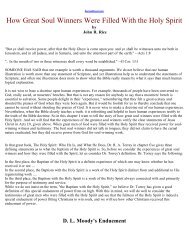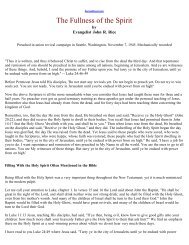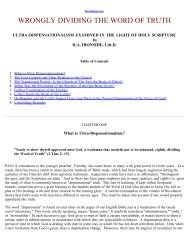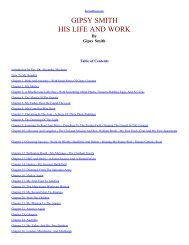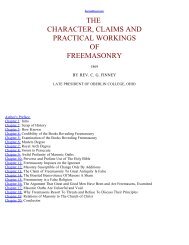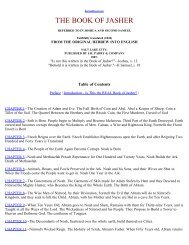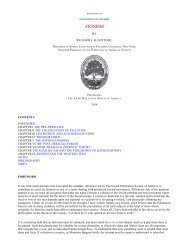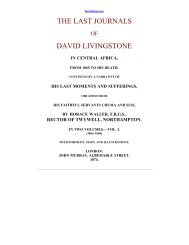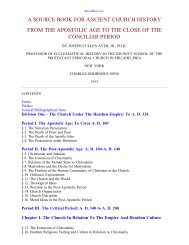Legends of Babylon and Egypt in Relation to Hebrew Tradition.pdf
Legends of Babylon and Egypt in Relation to Hebrew Tradition.pdf
Legends of Babylon and Egypt in Relation to Hebrew Tradition.pdf
You also want an ePaper? Increase the reach of your titles
YUMPU automatically turns print PDFs into web optimized ePapers that Google loves.
period when some progress <strong>in</strong> systematic irrigation had already been made, <strong>and</strong> the fill<strong>in</strong>g <strong>of</strong> the dry canals <strong>and</strong><br />
subsequent irrigation <strong>of</strong> the parched ground by the ris<strong>in</strong>g flood <strong>of</strong> Enki was not dreaded but eagerly desired. The myth<br />
is only one <strong>of</strong> several that have been comb<strong>in</strong>ed <strong>to</strong> form the <strong>in</strong>troduc<strong>to</strong>ry sections <strong>of</strong> an <strong>in</strong>cantation; but <strong>in</strong> all <strong>of</strong> them<br />
Enki, the god <strong>of</strong> the deep water, plays the lead<strong>in</strong>g part, though associated with different consorts.[1] The <strong>in</strong>cantation is<br />
directed aga<strong>in</strong>st various diseases, <strong>and</strong> the recitation <strong>of</strong> the clos<strong>in</strong>g mythical section was evidently <strong>in</strong>tended <strong>to</strong> enlist the<br />
aid <strong>of</strong> special gods <strong>in</strong> combat<strong>in</strong>g them. The creation <strong>of</strong> these deities is recited under set formulae <strong>in</strong> a sort <strong>of</strong> refra<strong>in</strong>,<br />
<strong>and</strong> the div<strong>in</strong>e name assigned <strong>to</strong> each bears a magical connexion with the sickness he or she is <strong>in</strong>tended <strong>to</strong> dispel.[2]<br />
[1] See Langdon, Univ. <strong>of</strong> Penns. Mus. Publ., Bab. Sect., Vol. X, No. 1 (1915), pl. i f., pp. 69 ff.; /Journ. Amer. Or.<br />
Soc./, Vol. XXXVI (1916), pp. 140 ff.; cf. Pr<strong>in</strong>ce, /Journ. Amer. Or. Soc./, Vol. XXXVI, pp. 90 ff.; Jastrow, /Journ.<br />
Amer. Or. Soc./, Vol. XXXVI, pp. 122 ff., <strong>and</strong> <strong>in</strong> particular his detailed study <strong>of</strong> the text <strong>in</strong> /Amer. Journ. Semit.<br />
Lang./, Vol. XXXIII, pp. 91 ff. Dr. Langdon's first description <strong>of</strong> the text, <strong>in</strong> /Proc. Soc. Bibl. Arch./, Vol. XXXVI<br />
(1914), pp. 188 ff., was based on a comparatively small fragment only; <strong>and</strong> on his completion <strong>of</strong> the text from other<br />
fragments <strong>in</strong> Pennsylvania. Pr<strong>of</strong>essor Sayce at once realized that the prelim<strong>in</strong>ary diagnosis <strong>of</strong> a Deluge myth could not<br />
be susta<strong>in</strong>ed (cf. /Expos. Times/, Nov., 1915, pp. 88 ff.). He, Pr<strong>of</strong>essor Pr<strong>in</strong>ce, <strong>and</strong> Pr<strong>of</strong>essor Jastrow <strong>in</strong>dependently<br />
showed that the action <strong>of</strong> Enki <strong>in</strong> the myth <strong>in</strong> send<strong>in</strong>g water on the l<strong>and</strong> was not punitive but beneficent; <strong>and</strong> the<br />
preced<strong>in</strong>g section, <strong>in</strong> which animals are described as not perform<strong>in</strong>g their usual activities, was shown <strong>in</strong>dependently by<br />
Pr<strong>of</strong>essor Pr<strong>in</strong>ce <strong>and</strong> Pr<strong>of</strong>essor Jastrow <strong>to</strong> have reference, not <strong>to</strong> their different nature <strong>in</strong> an ideal existence <strong>in</strong> Paradise,<br />
but, on familiar l<strong>in</strong>es, <strong>to</strong> their non-existence <strong>in</strong> a desolate l<strong>and</strong>. It may be added that Pr<strong>of</strong>essor Bar<strong>to</strong>n <strong>and</strong> Dr. Peters<br />
agree generally with Pr<strong>of</strong>essor Pr<strong>in</strong>ce <strong>and</strong> Pr<strong>of</strong>essor Jastrow <strong>in</strong> their <strong>in</strong>terpretation <strong>of</strong> the text, which excludes the<br />
suggested biblical parallels; <strong>and</strong> I underst<strong>and</strong> from Dr. Langdon that he very rightly recognizes that the text is not a<br />
Deluge myth. It is a subject for congratulation that the discussion has materially <strong>in</strong>creased our knowledge <strong>of</strong> this<br />
difficult composition.<br />
[2] Cf. Col. VI, ll. 24 ff.; thus /Ab/-u was created for the sickness <strong>of</strong> the cow (/ab/); N<strong>in</strong>-/tul/ for that <strong>of</strong> the flock (u-<br />
/tul/); N<strong>in</strong>- /ka/-u-tu <strong>and</strong> N<strong>in</strong>-/ka/-si for that <strong>of</strong> the mouth (/ka/); Na-zi for that <strong>of</strong> the /na-zi/ (mean<strong>in</strong>g uncerta<strong>in</strong>); /Da<br />
zi/-ma for that <strong>of</strong> the /da-zi/ (mean<strong>in</strong>g uncerta<strong>in</strong>); N<strong>in</strong>-/til/ for that <strong>of</strong> /til/ (life); the name <strong>of</strong> the eighth <strong>and</strong> last deity is<br />
imperfectly preserved.<br />
We have already noted examples <strong>of</strong> a similar use <strong>of</strong> myth <strong>in</strong> magic, which was common <strong>to</strong> both <strong>Egypt</strong> <strong>and</strong> <strong>Babylon</strong>ia;<br />
<strong>and</strong> <strong>to</strong> illustrate its employment aga<strong>in</strong>st disease, as <strong>in</strong> the Nippur document, it will suffice <strong>to</strong> cite a well-known<br />
magical cure for the <strong>to</strong>othache which was adopted <strong>in</strong> <strong>Babylon</strong>.[1] There <strong>to</strong>othache was believed <strong>to</strong> be caused by the<br />
gnaw<strong>in</strong>g <strong>of</strong> a worm <strong>in</strong> the gum, <strong>and</strong> a myth was used <strong>in</strong> the <strong>in</strong>cantation <strong>to</strong> relieve it. The worm's orig<strong>in</strong> is traced from<br />
Anu, the god <strong>of</strong> heaven, through a descend<strong>in</strong>g scale <strong>of</strong> creation; Anu, the heavens, the earth, rivers, canals <strong>and</strong> marshes<br />
are represented as each giv<strong>in</strong>g rise <strong>to</strong> the next <strong>in</strong> order, until f<strong>in</strong>ally the marshes produce the worm. The myth then<br />
relates how the worm, on be<strong>in</strong>g <strong>of</strong>fered tempt<strong>in</strong>g food by Ea <strong>in</strong> answer <strong>to</strong> her prayer, asked <strong>to</strong> be allowed <strong>to</strong> dr<strong>in</strong>k the<br />
blood <strong>of</strong> the teeth, <strong>and</strong> the <strong>in</strong>cantation closes by <strong>in</strong>vok<strong>in</strong>g the curse <strong>of</strong> Ea because <strong>of</strong> the worm's misguided choice. It is<br />
clear that power over the worm was obta<strong>in</strong>ed by a recital <strong>of</strong> her creation <strong>and</strong> <strong>of</strong> her subsequent <strong>in</strong>gratitude, which led<br />
<strong>to</strong> her present occupation <strong>and</strong> the curse under which she laboured. When the myth <strong>and</strong> <strong>in</strong>vocation had been recited<br />
three times over the proper mixture <strong>of</strong> beer, a plant, <strong>and</strong> oil, <strong>and</strong> the mixture had been applied <strong>to</strong> the <strong>of</strong>fend<strong>in</strong>g <strong>to</strong>oth,<br />
the worm would fall under the spell <strong>of</strong> the curse <strong>and</strong> the patient would at once ga<strong>in</strong> relief. The example is <strong>in</strong>structive,<br />
as the connexion <strong>of</strong> ideas is quite clear. In the Nippur document the recital <strong>of</strong> the creation <strong>of</strong> the eight deities evidently<br />
ensured their presence, <strong>and</strong> a demonstration <strong>of</strong> the mystic bond between their names <strong>and</strong> the correspond<strong>in</strong>g diseases<br />
rendered the work<strong>in</strong>g <strong>of</strong> their powers effective. Our knowledge <strong>of</strong> a good many other myths is due solely <strong>to</strong> their<br />
magical employment.<br />
[1] See Thompson, /Devils <strong>and</strong> Evil Spirits <strong>of</strong> <strong>Babylon</strong>ia/, Vol. II, pp. 160 ff.; for a number <strong>of</strong> other examples, see<br />
Jastrow, /J.A.O.S./, Vol. XXXVI, p. 279, n. 7.<br />
Perhaps the most <strong>in</strong>terest<strong>in</strong>g section <strong>of</strong> the new text is one <strong>in</strong> which div<strong>in</strong>e <strong>in</strong>structions are given <strong>in</strong> the use <strong>of</strong> plants,<br />
the fruit or roots <strong>of</strong> which may be eaten. Here Usmû, a messenger from Enki, God <strong>of</strong> the Deep, names eight such<br />
plants by Enki's orders, thereby determ<strong>in</strong><strong>in</strong>g the character <strong>of</strong> each. As Pr<strong>of</strong>essor Jastrow has po<strong>in</strong>ted out, the passage<br />
forcibly recalls the s<strong>to</strong>ry from Berossus, concern<strong>in</strong>g the mythical creature Oannes, who came up from the Erythraean<br />
Sea, where it borders upon <strong>Babylon</strong>ia, <strong>to</strong> <strong>in</strong>struct mank<strong>in</strong>d <strong>in</strong> all th<strong>in</strong>gs, <strong>in</strong>clud<strong>in</strong>g "seeds <strong>and</strong> the gather<strong>in</strong>g <strong>of</strong>



